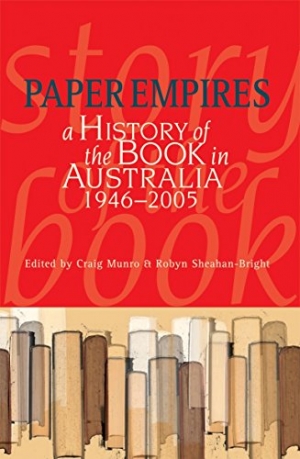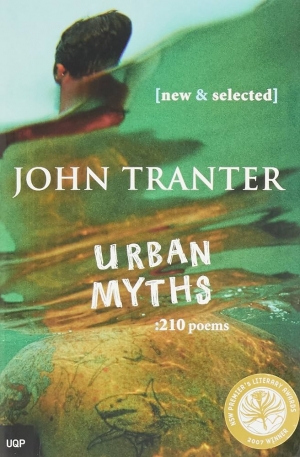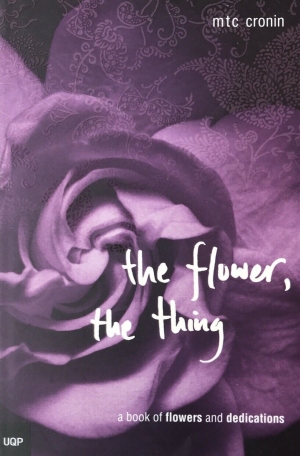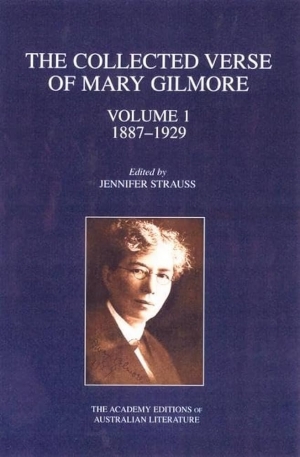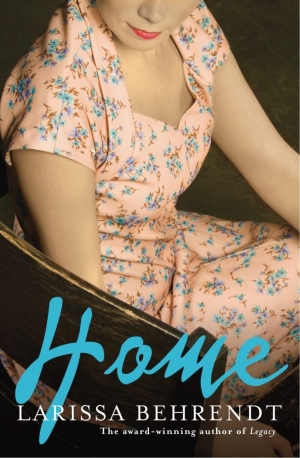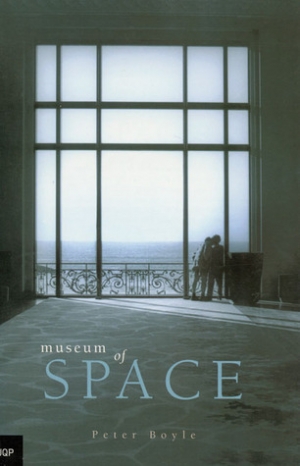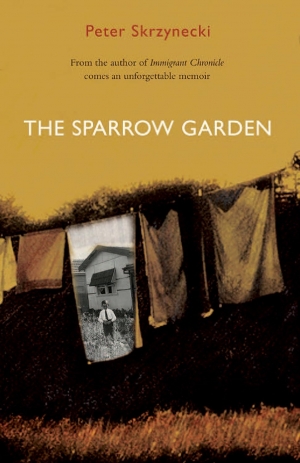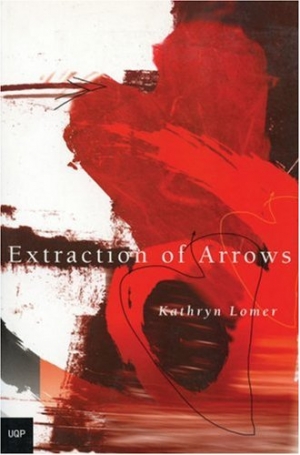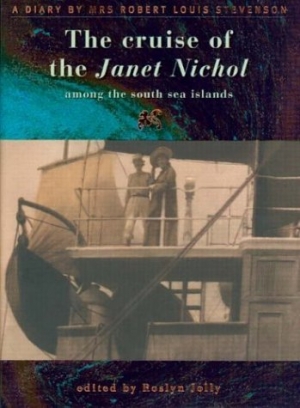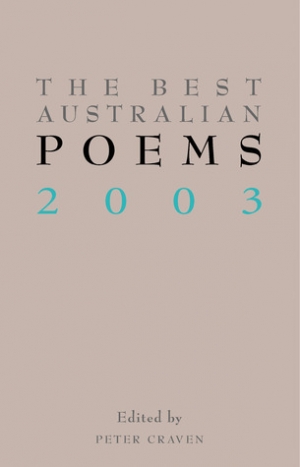UQP
This eagerly awaited volume is the last in a trilogy which will recount the history of the book in Australia. The first volume, which will cover the years to 1890, is in preparation. Volume Two, A History of the Book in Australia, 1891–1945: A National Culture in a Colonised Market, edited by Martyn Lyons and John Arnold, was published in 2001.
What is a history of the book? The present volume regrettably does not tell us. We need to consult Volume Two, where Martyn Lyons tells us that it is the history of print culture: ‘The historian of the book is concerned not just with the creative imagination but with all the processes of production, including typesetting, binding, illustration, editing, proofreading, designing, and publishing.’ In addition to the history of book production, the history of print culture encompasses distribution and reception, which involves bookshops and booksellers, libraries and librarians, and, by no means least, readers. The promotion of reading and its hindrance (censorship and other factors) are important topics. It is a broad canvas.
... (read more)Martin Duwell reviews ‘Urban Myths: 210 poems’ by John Tranter
This new and selected poems reminds us, if we needed reminding, just how powerful John Tranter’s cumulated work is. There is a density, an intensity, and a many-sided explorativeness that probably cannot be matched in Australian poetry. Surprisingly, at 210 poems, it is a comparatively small book and has been pretty ruthlessly selected, but there is no doubting the size of its author’s achievement.
... (read more)Rose Lucas reviews ‘The Flower, The Thing’ by M.T.C. Cronin and ‘The Last Tourist’ by Jane Williams
What shapes might poets use to house and craft their various perceptions? Given the absence of a narrative framework, particularly within lyric poetry, what are the possible images and contents through which poetry might weave its insights, and thereby build a tangible structure able to communicate the ephemera of experience and idea? In her most recent collection of poems, M.T.C. Cronin, surely one of the most significant poets writing in Australia today, works explicitly within the artifice of a given structure – a series of poems, titled for alphabetically organised flowers, each with its own specific dedication.
... (read more)Vivian Smith reviews ‘The Collected Verse Of Mary Gilmore, Volume 1: 1887–1929’ edited by Jennifer Strauss
Mary Gilmore is one of the most acclaimed figures in Australian writing. A cultural icon, she appears in important paintings and sculptures and on postage stamps, not to mention the ten-dollar note. Her biography has been published, her letters collected, and now the first volume of her complete poems, edited by Jennifer Strauss, has appeared in the prestigious Academy Editions of Australian Literature. No other Australian poet except Henry Lawson has received quite the degree of attention that Gilmore has been accorded. Longevity certainly had something to do with her fame: she was a living link between the colonial Australia she was born into and the Australia of the 1960s that saw her passing. Like Lawson’s, her life and work are written into Australian history; and she too is inextricably associated with the legend of the 1890s. She never quite achieved Lawson’s popularity as a writer, but this edition makes it clear that her fame was truly earned, not merely accrued. No literary reputation is ever finally fixed, or immune to criticism, but this book will help us to understand why Gilmore, Australia’s foremost woman poet during the first half of the twentieth century, came to be considered a national treasure.
... (read more)A few years ago, it seemed that anyone with a personal or family story to tell – even first-time authors – wrote a memoir rather than distilling those experiences into fiction. Think of Kate Shayler’s The Long Way Home (2001) or Sonia Orchard’s Something More Wonderful (2003). Many claimed this was because, at a moment when Australian memoir was resurgent, publishers were not supporting first-time novelists. But the tide may be turning. Recently, a number of autobiographical novels by new writers have appeared, well promoted and capturing the public’s attention, including Sophie Cunningham’s Geography (2004) and now Larissa Behrendt’s Home.
... (read more)‘His poems, now more and more exclusively in prose, have become taut and aphoristic, for he seeks patiently to release energy potential in language, and to make of poetry an instrument of revelation, indeed a close ally of philosophy.’
These words, by R.T. Cardinal in The Penguin Companion to European Literature (1969), in fact gloss the poetry of René Char. They could be taken as an apt description of Peter Boyle’s fourth collection, Museum of Space, which represents a subtle but significant shift in his oeuvre since the virtuoso What the Painter Saw in Our Faces (2001). These are sparer, more abstract poems, less cluttered by competing images – deft, attenuated and often written in a lean, delicate prose, as if having left some of the mechanical devices of poetry behind for something more suggestively metaphysical.
... (read more)In ‘St Patrick’s College’ a poem that appears in his 1975 collection Immigrant Chronicle, Peter Skrzynecki recalls the last day of school, when ‘mass was offered up for our departing intentions’, after which the young Peter makes his way home, ‘taking the right-hand turn out of Edgar Street for good’. It is characteristic of Skrzynecki that he should locate such a crucial turning point in his life so precisely, naming the very street that led him to it. It is this impulse to map, to plot the coordinates of a life, that lies behind much of Skrzynecki’s work, forming a grid by which he reads the past and makes sense of it. ‘The streets of Regents Park,’ he says elsewhere, ‘run through my blood /even though I don’t live there anymore’.
... (read more)Kathryn Lomer’s Extraction of Arrows is a fine first book. It is more unified than most, but with a varied enough poetic base to make one interested in the poems that Lomer will write in the future. Its essential feature is a tight focus on the self; as lyric poetry should be, it is ‘self-centred’, without any of the pejorative overtones of that phrase. At almost all points, we are aware of the poet herself, a body existing alongside a compendium of moods, experiences and emotions. It is a carefully observed body, especially in a poem such as ‘Linea Nigra’, which begins:
... (read more)Kate Darian-Smith reviews ‘The Cruise of the Janet Nichol among the South Sea Islands: A diary by Mrs Robert Louis Stevenson’ edited by Roslyn Jolly, ‘Robert Louis Stevenson: His best Pacific writings’ edited by Roger Robinson and more
Whether it’s fate or mere coincidence, the life stories of the two most celebrated writers of the Pacific – Robert Louis Stevenson and Albert Wendt – dovetail together on the small tropical island of Upolu in Western Samoa. In 1889, when Stevenson concluded his third Pacific cruise on the Janet Nichol, he told his readers in Europe and America that: ‘Few men who come to the islands leave them; they grow grey where they alighted; the palm trees and trade-wind fan them till they die.’ In hindsight, this reads as a premonition, but, after years of ill-health Stevenson was seduced and invigorated by sweet air and unexpected interests, describing his time during the Pacific voyages as ‘passing like days in fairyland’.
... (read more)David McCooey reviews ‘The Best Australian Poems 2003’ edited by Peter Craven and ‘The Best Australian Poetry 2003’ edited by Martin Duwell
Writing this on the first Tuesday in November, I am struck by how different contemporary Australian poetry is from the Melbourne Cup. There is no money in poetry, of course, and in horse racing everyone, even the horses, are much better dressed. What’s more, despite complaints to the contrary, the returns are usually better when it comes to reading poetry than spending your days at the TAB. Martin Duwell’s The Best Australian Poetry 2003 and Peter Craven’s The Best Australian Poems 2003 are dead certs, compared to the boundless unreliability of horses.
... (read more)
